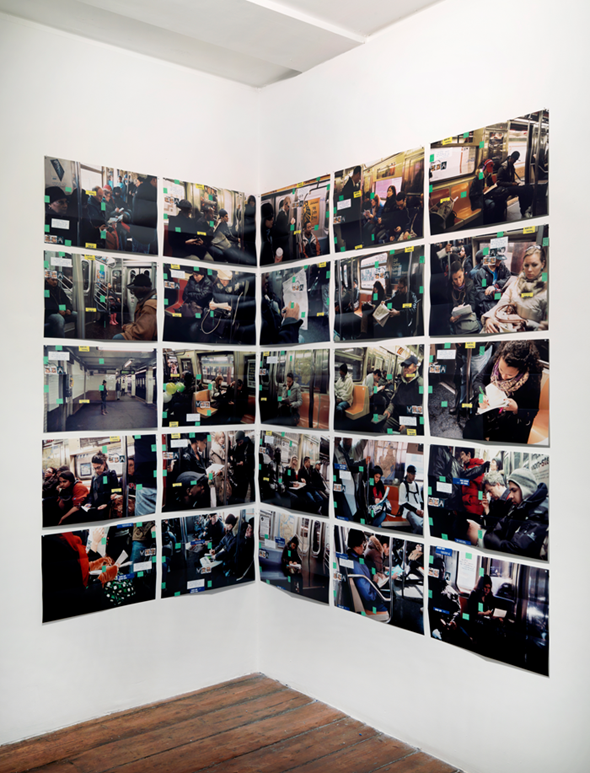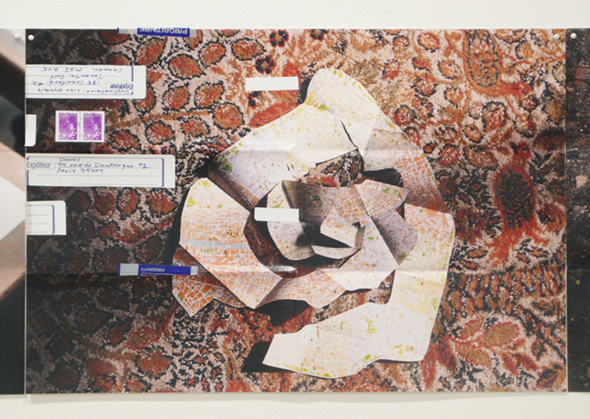
All images: Courtesy Murray Guy, New York
The aura of the everyday, the analogue, the hand, the elegiac. In the photographic œuvre of Canadian artist MOYRA DAVEY, FIONN MEADE finds an obsession with collecting, systematic recording and nostalgic resistance that lend a paradoxical contemporaneity to her work.
As the saying goes, truth may reside in images but there is no image of truth. Images belong to the intermediary things of life – inscriptions, pictures, signs – and remain dependent upon routine patterns of behavior and looking in order to approach a way of seeing. Images are contingent, flawed things, belonging to the domain of appearance that proved irksome and recalcitrant to Plato and others – bad copies of reality that some believe should be resisted for what ultimately lies behind the impression or imprint. Perhaps. But the contingent image is a fateful thing, for it spurs the re-combinatory desire of looking, it seeks companions and associates. It dips into the collecting impulse that allows for an image to be in part significant, but in need of revisiting; it propels and allows appearances to re-emerge and find each other. The needy image becomes a substitute imbued with the desire to order and re-order. It departs from solitary representation and approaches the cut of montage. It enters into what Walter Benjamin identifies as the mnemonic shape of the, »collector’s passion,« that restless yet specific tracing that, »manifests a dialectical tension between the poles of disorder and order ... a relationship to objects which does not emphasize their functional, utilitarian value – that is, their usefulness – but studies and loves them as the scene, the stage, of their fate.«1
In looking at Moyra Davey’s work one identifies the collector’s impulse to return to certain past images and bring them into contact with new entries, new inquiries. The image becomes fateful and propulsive, something to be studied and re-examined but also implicated into action. Here, the image adheres and needs proximity. It claims its scene and stage by becoming a unique form of montage. 50 Photographs, 2003, for example, is what Davey calls a »bloom« sequence, in this case page-sized photos that peer into the worn languor of a collector’s melancholia and the pleasure of fetishistic materiality. Prone to a matter-of-fact intimacy, the sequence mines a domestic space void of human protagonists. Close-up and distanced views frame the residual underpinnings of daily life: a bare light fixture, an empty liquor bottle, stacks of analog stereo equipment, books and records everywhere, the needle of a record player, the recurrent imposition of a pipe, a hallway scorched with sunlight, dust under a dog’s paw. Tracing the cultivated acts of reading, listening and collecting, the photographic space of 50 Photographs is an interior terrain removed from the promise of street encounter or figurative subject. Not staid but associative, it records an analog view of absence and of a life unfolding in an elegiac register.
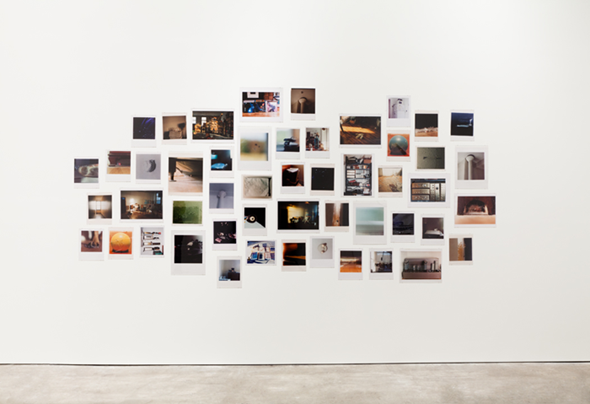
Installation view American Fine Arts Co., New York
Courtesy Murray Guy, New York
Perhaps less wounds than spaces of attentiveness, the gaps in between the images of 50 Photographs (as much as the pictures themselves) convey a state of mind, a mood, and a structure of feeling that takes strange comfort in the in-between. A melancholy reserve haunts the unadorned presentation, each image nailed behind a thin sheet of Plexiglas – often exceeding and fraying out beyond its slight frame. The eros and tension of this work resides in its negotiated status of desire, existing in obsession and consolation, tacking between the offhand and highly constructed. It should be no surprise that images from this work, initially shown at Colin de Land’s gallery American Fine Arts in 2003, have regularly resurfaced in Davey’s subsequent work. It is a sequence that commemorates isolation but also begins to see anew, evoking a critical juncture from whence Davey’s work has relied more and more upon associative methods and less upon indexical convention.
The selection and editing of her images into sequences takes on a re-combinatory logic in specific works and also in Davey’s choreography of exhibitions. Reminiscent of a bookshelf’s constant re-ordering in the house of a reader, or a new addition to the stack of familiar records in the house of a listener, Davey often includes parts of her past image repertoire in new presentations; a triptych of leaning LP records were stacked vertically in a show at Murray Guy gallery in 2009, while they splayed left to right in an exhibition at The Fogg Museum in 2008. Similarly, enlarged images culled from 50 Photographs unfolded left to right in sequences of four, three, and seven in the Speaker Receiver exhibition at Kunsthalle Basel in 2010. As with her key early work, Copperheads, 1990, which zoomed in on the pocked, scratched, gouged, oxidized, melted, and scathed erasings of Abraham Lincoln’s profile on ninety-nine U. S. pennies, Davey’s editorial style allows for showing the entire Copperheads series in a grid (as at the Fogg Museum) or in excerpted iterations. This approach reveals both the collector’s obsessive re-ordering and a distinctive acuity for montage. Within her exhibition, My Necropolis, at Murray Guy, Davey took advantage of the gallery's intimate proximity by encircling the viewer, while the airy rooms of the Kunsthalle Basel insisted upon long pauses between works.
Davey’s work also extends outward into the city, though more via typology than associative sequence. Rather than the scavenged for record, out-of-print paperback, or drained whiskey bottle – image-objects identified with Davey’s interior retinue – her civic viewfinder seeks out variations upon everyday gestures and markings of economic circulation. Subway – writers, 2011, for instance, recalls her earlier Newsstand photographs, 1994, as Davey surreptitiously captured New York City commuters scribbling notes, underlining texts, making lists, etc., all with stylus in hand. The ubiquity of screen culture is de-emphasized – mobile phones, iPads, and e-readers barely visible – in favor of the shuffle and scrawl of script. Employing a grid in place of a »bloom«, Davey follows a behavior and mode of technology –handwriting – with an insistence that paradoxically intimates its increased obsolescence. Distinct from the exuberant vérité moments in Helen Levitt’s clandestine street images, for example, Davey’s variations capture engrossed, intermediary moments of urban life.
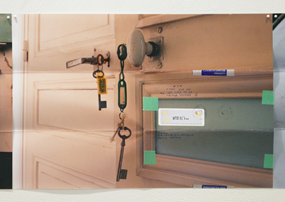
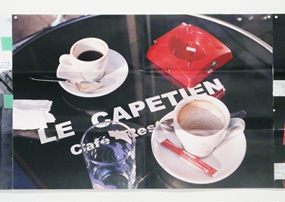
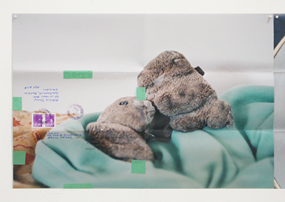
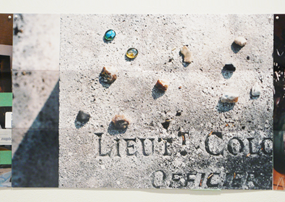
As with the series 9 Photographs from Paris and 32 Photographs from Paris, both 2009, Davey’s recent grid works retain the marks of each photo having been folded and mailed via the postal service to individuals at the galleries and museums where they are shown. Bearing the residual creases, stamps, and tape marks of economic circulation, Davey’s version of traveling images retain the process of dispersal that lends them the unique surface of re-assembled artifacts and objects. Addressed to the person likely to handle the intake of the work, the actual receiver, this mode of exposure counters the taxonomic and evidentiary implications of the grid with a mien of imperfection while also revealing something of the social structure of the presenter. The folding, the act of including the hand in her images, further imbues the series with the function of a message, a missive sent from one desk to another. In Davey’s de-framing gesture, the images are weakened by conventional standards – handled, waylaid, equalized – even as they become tokens of extended sensibility and observation. And this is why Davey’s work can be thought of as the lover’s addenda, departing from the collector’s passionate intensity but made to function in the mode of a message sent in parts, the absent and missing body allowed back in through affective identification and direct address.
The Coffee Shop, The Library, 2011, a work recently on view at MoMA, in New York, finds Davey linking public places that retain a measure of solitude, contrasting the quieted perusal of the museological archive with the time to sit and think over an espresso. In Davey’s still-life arrangements of the same café order –espresso and a glass of water – shot from above, the »coffee shop« of the title becomes the place of compositional time – table, no food, the minimal accompaniment. It is the break before returning to one’s research, the time to ruminate upon correlations that now require further enunciation. It is the composing time when the memory of a camera’s blurred gaze outward through a restaurant window to a man holding a flower extended, Saul Leiter’s Flower (variant), 1952, returns and needs to be brought close to the impression made by Bruce Davidson’s The Dwarf, 1958, and its view inward upon a forlorn figure seated alone in a coffee shop before a vase of wilted flowers. Accompanied by Davey’s nearby desktop image of paperclips, pens, and pins, the intruding light upon café tables becomes the bare place of considering the layered associations, the act of remembrance made into visual correspondence, the memory table.
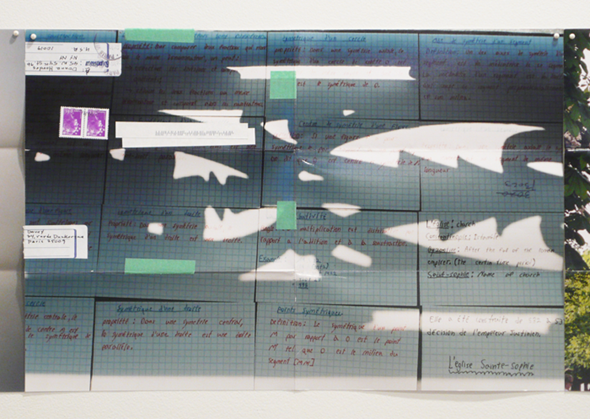
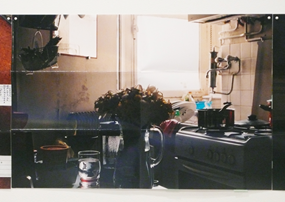
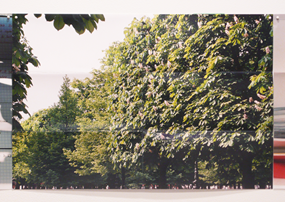
Within the dizzying references of the MoMA’s library, Davey selects the neutralized and bound pages of seminal art and architecture magazines L’Oeil and Pencil Points, only to elide them with past images of her own dusty bookshelves. Holding open MoMA card catalog entries to Eugène Atget acquisitions, Davey reminds us of her own writing on Atget and his haunting punctuation of urban absence, also managing to acknowledge the work of American photographer Berenice Abbott, who steadfastly advocated for Atget’s work following his death and whose Atget portfolio MoMA purchased in 1968. The sound of archival time is further evoked in an image of a library record player and analog tape-decks, and the work slowly attains the vertiginous movement of cultural memory wherein details re-surface and seek company, where erudition falls back into material semblance, and where a collector’s acuity and vulnerability is needed, as one who, »studies and loves.« In the lower left corner of the grid, next to a card entry for Atget’s »Masque Antique,« resides just such a detail of the collector’s memory. A napkin surface bears the initials »PH MD JS ST CD« with numerical tabulations below. Evidence of Colin de Land’s habit of dividing up restaurant checks on napkins, the behavioral quirk becomes memorial here as it remembers de Land and his wife, »PH,« the art dealer Pat Hearn, while »MD« and »JS« return us to those very much with us, Moyra Davey and Jason Simon, the artist’s husband and fellow artist (ST is a mystery). It is this kind of inclusion, the montage cut of the personal alongside the institutional and art historical, that re-animates looking, and recalls Roland Barthes’ late summation in a 1978 lecture of the archive’s ability to live again:
»This library of dead authors → That could toll the funerary, retrograde bell (≠ doxa: to interest oneself in the present, to let the dead bury the dead, etc.). I don’t take it that way: (a) Critical, creative distance: to get myself vividly interested in what is contemporaneous to me, I might need the detour through death (History); Michelet’s example: absolutely present to his century but working on the ›life‹ of the Dead: I make the dead think in myself; the living surround me, penetrate me, lock me up precisely in an echo chamber – of which I am more or less conscious – but only the Dead are creative objects = we are all caught up in ›fashions,‹ and they are useful; but only death is creative.«2
From this we return to an early work by Davey, one with the searing title Long Life Cool White, 1999. Gleaned from the tiny words of a manufacturing guarantee minutely visible on the well-worn fluorescent bulbs that foreground Davey’s photograph, the image frames a blurred view into a room replete with books, file folders, a city map on the wall, and the ineluctable eye of a large-format camera just beyond the field of focus. The image is an allegory for the detour Barthes reminds us of. It is a place of future action – lights to be switched on, an expectant apparatus, travels to be made into the city, pages to be creased, images to be looked at once again, re-routed – it is the time of the studio captured. The excerpted industrial phrase »Long Life Cool White« becomes a line of poetry to match the flare of light just catching the bottom left corner of the image, it tells us this is a room that breathes, this is a place of return, a place of vision, a place filled with future memory.
1 Walter Benjamin, »Unpacking My Library«, in: Walter Benjamin: Selected Writings, Vol. 2, 1927–1934, Harvard University Press, 1999, p. 487.
2 Roland Barthes, The Neutral, Columbia University Press 2005, p. 9
FIONN MEADE is a curator and writer living in New York.
MOYRA DAVEY, born in 1958 in Canada. Lives in New York. Recent solo exhibitions include greengrassi, London (2011); Speaker Receiver, Kunsthalle Basel (2010); My Necropolis, Murray Guy, New York (2009); Long Life Cool White, The Fogg Art Museum, Harvard University, Cambridge, MA (2008). Recent exhibition participations include New Photography 2011, MoMA, New York; After The Gold Rush, Metropolitan Museum of Art, New York (2011); Atlas, Museo Nacional Centro de Arte Reina Sofia, Madrid; Sound and Vision, The Art Institute of Chicago (2010); LʼArgent, Le Plateau, Ile-de-France, Paris (2008); Calendar of flowers, gin bottles, steak bones, Orchard, New York (2007).
Represented by greengrassi, London; Murray Guy, New York; Goodwater Gallery, Toronto
